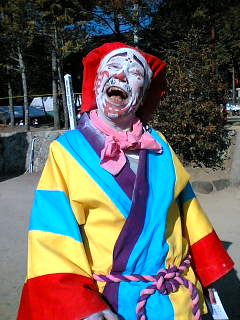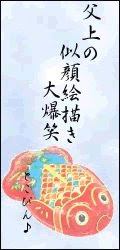[ . BACK to WORLDKIGO TOP . ]
:::::::::::::::::::::::::::::::::::::::::::::::::::::::::::::::::::::::::::::::::::::::::::::::::::
First Laugh (hatsu warai, hatsuwarai)
***** Location: Japan
***** Season: New Year
***** Category: Humanity
*****************************
Explanation
First laugh, waraizome 笑初 (わらいぞめ)
..... hatsu warai 初笑(はつわらい)
First smiling face, hatsu egao 初笑顔(はつえがお)
First smile, hatsu ekubo 初えくぼ(はつえくぼ)
 Click for more information about
Click for more information about
the Seven Gods of Good Luck !
:::::::::::::::::::::::::::::::::::::::::::::::::::::::::::::::::::::::::::::::::::::::::::::::::::::
First cry, nakizome 泣初 (なきぞめ)
..... hatsu naki 初泣(はつなき)
::::::::::::::::::::::::::::::::::::::::::::::::::::::::::::::::::::::::::::::::::::::::::::::::::
Lucky Laugh, fuku warai 福笑い (ふくわらい)
..... okametsuke おかめつけ

 Sacred Lucky Laughing
Sacred Lucky Laughing
Laughing Your Way to Heaven
It may seem comical to the outsider, but for residents of Hofu, Yamaguchi 防府市大道小俣地区Prefecture, the
waraiko is a serious affair. On the first Sunday of December, the chief priest of a local Shinto shrine 小俣神社 leads 21 parishioners in an ancient ceremony to offer one's heartiest laughter to the gods.
http://web-japan.org/kidsweb/explore/calendar/december/waraiko.html
This is a ceremony to bring the old year to an end.
ootoshi sai 大歳祭
This is one of the special exceptional ceremonies of Japan. Since Showa 44 it has become an intangible cultural property of the town.
This ceremony is more than 800 years old (since 正治(しょうじ)元年(1199)) and lasts from 11 in the morning till 3 in the afternoon at the home of the Elder for this Ceremony, who is changing every year. They welcome the God of the Year (ootoshigami 大歳神) to his home to entertain him with their laugh.
21 men, one of each household, take part in it. They give thanks for the harvest of this year and pray for a good one in the next. Each then receives a big bowl or some bamboo twigs and lifts it to his head, laughing loud three times:
Wahahaha ! first to thank for the harvest of this year,
Wahahaha ! second to pray for a good harvest next year and
Wahahaha ! a third time to forget the bad things and the sad things of the last year.
 わっはっハッハッ、わっはっハッハッ、わっはっハッハッ
わっはっハッハッ、わっはっハッハッ、わっはっハッハッ
Then they drink sacred ricewine (miki) whilst sitting facing each other, lifting the cup and laughing three times for each toast. If the Elder of the Group finds the laugh was not from the heart and true or did not express enough funny dignity, he would bang on a metal washbowl and they have to repeat it.
The
Laughing Group, Warai-Koo 「笑い講」is a serious matter, after all !
I watched on TV this year and we ended up laughing our way right toward heaven too! A rather funny serious ceremony. I will try and find more about its origin.
 External LINK with many pictures
The Laughing Festival
External LINK with many pictures
The Laughing Festival
More about
Laughing in Japan
http://tillchan.typepad.com/laughing/
*****************************
Worldwide use
*****************************
Things found on the way
*****************************
HAIKU
 source : www.miho.or.jp
Sekisoro singers
source : www.miho.or.jp
Sekisoro singers - Haiga by Yosa Buson 与謝蕪村
- - - Matsuo Basho laughs - - -
節季候を雀の笑ふ出立かな
sekizoro o suzume no warau detachi kana
Year-end mummers
are a sight to make
the sparrows laugh
Tr. Addiss
source : books.google.co.jp
Written in December 1592, Genroku 5 元禄5年12月
. Year End Singers . sekizoro 節季候 .
with one more hokku by Basho
.............................................................................
春風に吹き出し笑ふ花もがな
haru kaze ni fukidashi warau hana mogana
O for flowers
That burst into laughter
In the spring wind.
Tr. Nelson and Saito
Spring winds.
Hoping the flowers burst
Out in laughter.
Tr. ?
Written in 寛文7年, Basho age 24.
in the spring wind
they will burst out into laughter,
these blossoms . . .
Tr. Gabi Greve
To say that flowers or cherry blossoms burst out into laughter in spring was a kind of cliche even at the time of Basho.
jootooku 常套句 jotoku cliche poem
jootoo 常套 cliche . クリシェ(french: cliché)
mogana, moga na もが‐な is the cutting word (kireji 切字)
at the end of line 3.
.............................................................................
笑ふべし泣くべしわが朝顔の凋む時
warau beshi naku beshi waga asagao no shibomu toki
should I laugh? should I cry?
when my morning glories
begin to wither
Tr. Gabi Greve
Written in 天和元年, Basho age 38
Here Basho also thinks about his own face as it changes when getting older.
This is a pun with the flower "asagao", "morning face" in Japanese.
. Face faces (kao 顔) .
Hokku about the Morning Glory (morning face)
. - asagao 朝顔 morning glory - .
Convolvulaceae family.
Hokku about crying (naku) by
. Matsuo Basho 松尾芭蕉 - Archives of the WKD .
:::::::::::::::::::::::::::::::::::::::::::::::::::::::::::::::::::::::::::::::::::::::::::::::::::::::
片乳を握りながらやはつ笑ひ
kata chichi o nigiri nagara ya hatsu warai
while grasping
mama's breast...
the year's first smile
乞食やもらひながらのはつ笑ひ
koijiki ya morai nagara no hatsu warai
a beggar receives
alms, the year's first
laughter
Kobayashi Issa
Tr. David Lanoue
:::::::::::::::::::::::::::::::::::::::::::::::::::::::::::::::::::::::::::::::::::::::::::::::::::::

chichiue no nigao-e kaki daibakushoo
painting the face
of my dear father -
exploding with laughter
They pass the painting to get into the laughing mood for the real ceremony !
© Asahi San
Tr. Gabi Greve
*****************************
Related words
*****
New Year's Tea, Good Luck Tea, lucky tea (fukucha) Japan
:::::::::::::::::::::::::::::::::::::::::::::::::::::::::::::::::::::::::::::::::::::::::::::::::::::
Chiba warai 千葉笑 (ちばわらい) "laughing in Chiba"
observance kigo for mid-winter
At the temple Chibadera 千葉寺 in the town of Chiba.
On the last day of the year, people assemble and have to hide their laughing faces until all at once break out in a huge laughter 嘲笑 (ちょうしょう chooshoo).
It is also the theme of a Kyogen play 千葉笑い.
 ameblo.jp/ttuminchu/archive1-200803.html
ameblo.jp/ttuminchu/archive1-200803.html
:::::::::::::::::::::::::::::::::::::::::::::::::::::::::::::::::::::::::::::::::::::::::::::::::::::
ban no warai 鷭の笑い(ばんのわらい)
laughter of a moorhen
animal kigo for all summer
Gallinula chloropus
:::::::::::::::::::::::::::::::::::::::::::::::::::::::::::::::::::::::::::::::::::::::::::::::::::::
waraitake 笑い茸(わらいたけ)"laughing mushroom"
plant kigo for all autumn
A poisonous mushroom that makes people laugh if they eat it.
Panaeolus papilionaceus
:::::::::::::::::::::::::::::::::::::::::::::::::::::::::::::::::::::::::::::::::::::::::::::::::::::
[ . BACK to DARUMA MUSEUM TOP . ]
[ . BACK to WORLDKIGO . TOP . ]
:::::::::::::::::::::::::::::::::::::::::::::::::::::::::::::::::::::::::::::::::::::::::::::::::::::




















